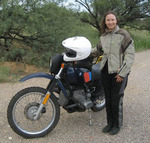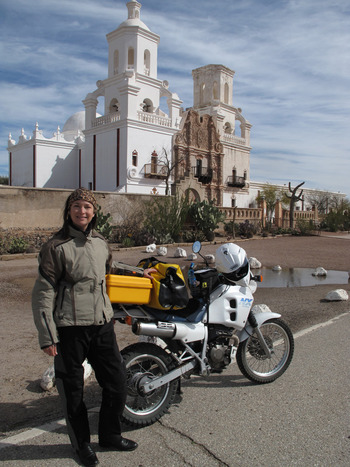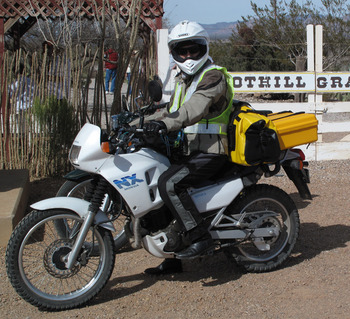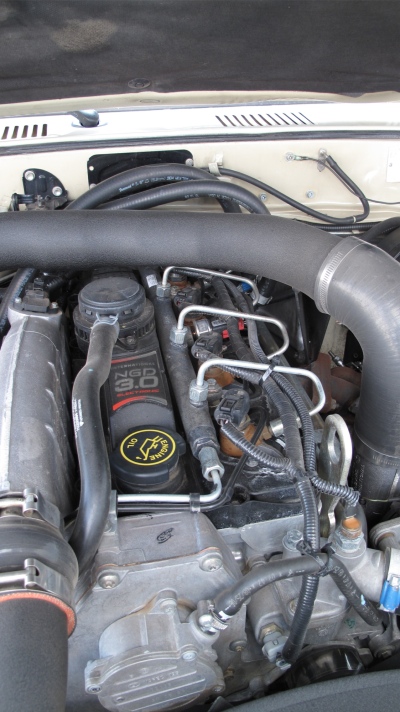
Overland Tech and Travel
Advice from the world's
most experienced overlanders
tests, reviews, opinion, and more
How do I find information for shipping a bike or vehicle overseas?
What are some resources for someone wanting to ship a Jeep overseas, such as China or Australia?
- David T., USA (via email)
Long Term Review: First Gear Monarch motorcycling jacket and Escape pants for women
 A couple of years ago I conducted an extensive review of armored motorcycling jackets suitable for touring and off-pavement riding. The selection ranged from a budget, Chinese-made, $300 offering from Fieldsheer to an outrageously exquisite $1,300 Rukka from Finland, presumably sewn by organically grown virgins in Helsinki.
A couple of years ago I conducted an extensive review of armored motorcycling jackets suitable for touring and off-pavement riding. The selection ranged from a budget, Chinese-made, $300 offering from Fieldsheer to an outrageously exquisite $1,300 Rukka from Finland, presumably sewn by organically grown virgins in Helsinki.
A bit up from the bottom of the pack pricewise was a First Gear Rainier, a $400 jacket made in Vietnam. It stood out in value with its combination of good quality and looks, comfortable armor, and effective waterproofing. Based on those initial impressions, Roseann decided to order a women’s Monarch jacket and Escape pants from the company. She’s now had two years and two motorcycles worth of time wearing the set, and we decided to do a long-term update.
 A couple of years ago I conducted an extensive review of armored motorcycling jackets suitable for touring and off-pavement riding. The selection ranged from a budget, Chinese-made, $300 offering from Fieldsheer to an outrageously exquisite $1,300 Rukka from Finland, presumably sewn by organically grown virgins in Helsinki.
A couple of years ago I conducted an extensive review of armored motorcycling jackets suitable for touring and off-pavement riding. The selection ranged from a budget, Chinese-made, $300 offering from Fieldsheer to an outrageously exquisite $1,300 Rukka from Finland, presumably sewn by organically grown virgins in Helsinki.
A bit up from the bottom of the pack pricewise was a First Gear Rainier, a $400 jacket made in Vietnam. It stood out in value with its combination of good quality and looks, comfortable armor, and effective waterproofing. Based on those initial impressions, Roseann decided to order a women’s Monarch jacket and Escape pants from the company. She’s now had two years and two motorcycles worth of time wearing the set, and we decided to do a long-term update.
An adventure-motorcycling jacket must strive to combine several features that are mutually exclusive. It must be warm in cold weather and cool in hot weather. It must be able to resist not just rain, but rain driven at 60mph or more, while allowing flow-through ventilation in sunny conditions. It must protect the wearer against abrasion and impact forces in a laydown on a trail or a more serious accident on pavement, while retaining freedom of movement and comfort, and avoiding bulk. Finally, it’s nice if the package looks good.
Obviously no jacket combines all these features perfectly. A Motoport Ultra II jacket in that first test boasted unequalled crash protection, but was so bulky that, as I mentioned at the time after looking in a mirror at my bloated profile, “Entomologists will think you’re pupating.”
On the other end of the fashion scale was the legendary waxed-cotton Barbour International, which lends anyone who dons it a rakish hint of Steve McQueen but which lacks any armor whatsoever. So picking a motorcycling jacket is a matter of deciding on one’s own priorities, up to and including style, while also keeping in mind keeping one’s mortality and fragile, evolutionarily compromised anatomy.
I was leery about including First Gear at the time of that review, since the company had been through several changes of ownership. But the current management, motorcycle equipment distributors Tucker Rocky, apparently had cracked the whip and gotten a handle on quality control. Roseann’s experience seems to confirm that—her jacket and pants have held up well, showing no fraying stitching, failing DWR (durable water-repellent) coating on the exterior, or even pilling on the fleece neck lining. Only the slightest wear on the inside of the knit cuffs is apparent.
In terms of performance, the rundown she gave me while I took notes adds up to a grade of about a solid B.
 The Monarch and Escape on its first tour, two years ago, during a March southern Arizona dirt-and-pavement weekend.First, she noted that the jacket really does seem to be cut for women in the shoulders, arms, and torso; it’s not merely a men’s small masquerading as gender-specific.
The Monarch and Escape on its first tour, two years ago, during a March southern Arizona dirt-and-pavement weekend.First, she noted that the jacket really does seem to be cut for women in the shoulders, arms, and torso; it’s not merely a men’s small masquerading as gender-specific.
Significantly, she mentioned that she’s able to forget the Knox CE-rated shoulder and elbow armor while riding; some armored jackets I’ve worn (such as that Motoport) never let you do so. Her only note was that the jacket’s arms fit somewhat loosely on her 115-pound frame even with the two Velcro cinch straps pulled all the way tight, resulting in some flapping at speeds over 110 mph. I think she was kidding about that last bit.
The pants, while also very comfortable around their armored hips, weren’t quite so forgettable in the knees: When in a normal riding position, Roseann found she needed to slightly hitch up each leg to arrange the knee armor comfortably on top of her knee rather than binding below it. This might be a personal fit issue, but it points out the importance of trying on armored cycling clothing before buying it if possible. Fortunately the knee issue is a small and correctable one.
Roseann rated ventilation in the Monarch as “adequate.” A seven-inch zippered vent in front of each shoulder lets in the breeze; corresponding vents in back let it out again. Small vents behind each sleeve add a bit of air movement up the arms. Considering Roseann’s Arizona-native tolerance for heat and preference for riding in the desert summer, I’d guess her “adequate” means ventilation in the Monarch could be slightly better.
There are two approaches to the conundrum of rain protection versus ventilation in motorcycling jackets. One is to make an outer armored jacket of breathable or even mesh material, and employ a separate inner waterproof (and frequently insulated) shell for dryness. This works well for mostly dry environments, but the waterlogged outer shell can become annoying if  Lacking sufficient reflective tape, Roseann opts to wear a safety vest when riding pavement; the pants' knee pads are a little low, and have to be manually adjusted each time the bike is mounted.experienced too frequently.
Lacking sufficient reflective tape, Roseann opts to wear a safety vest when riding pavement; the pants' knee pads are a little low, and have to be manually adjusted each time the bike is mounted.experienced too frequently.
The other approach is to make the outer shell waterproof, and ventilate it as well as possible with covered or waterproof zippers. The latter is the approach First Gear took; the Monarch is waterproofed with an interior coating of minimally breathable polyurethane (dubbed “Hypertex”) and an outer DWR coating.
Nevertheless, the company includes an inner shell incorporating a three-layer waterproof laminate (and a fleece lining). The outer jacket on its own has proven completely rain-tight so far. The inner jacket is stylish enough to be worn on its own, a good addition to kit for long journeys where you might need a jacket for visiting museums or restaurants.
With nary a spill to her credit, Roseann is in no position to rate the crash effectiveness of the Monarch and Escape. On paper, however, the specs look good. Both jacket and pants are sewn from 600-denier nylon, a step above the 500-denier fabric generally accepted as the minimum for adequate abrasion resistance. Kevlar underlay at knees, shoulders, and elbows should help prevent fabric tearing in an accident (Kevlar fibers resist shearing but, surprisingly, nylon is more abrasion-resistant). The CE-rated (Conformité Européenne) shock-absorbing armor is generously sized in the same three areas; a simpler closed-cell-foam pad adds some protection on the back.
On details and convenience, Roseann had nothing but praise. Pockets on both jacket and pants are plentiful, easy to access, and well-sealed with storm flaps or YKK water-resistant zippers. An MP3/phone pocket is completely protected inside. Jacket and pants zip together, enhancing both draft protection and safety in a fall and slide on pavement (when an unsecured jacket can ride up and expose skin).
All in all, Roseann’s experience with the Monarch and Escape seems to have reinforced the favorable impression my brief time with the Rainier left with me. First Gear has produced an affordable, yet comfortable and protective set of outerwear that should hold up well to extended riding.
Even if it’s not sewn by organically grown virgins in Helsinki.
* * * * * * * * * * *
First Gear Monarch Jacket, msrp $470 (5-year warranty, 2-year crash protection policy). Three colors, sizes XS-XXL. Men's equivalent: Teton Jacket. Now includes LED light that clips on back.
First Gear Escape Pant, msrp $380 (5-year warranty, 2-year crash protection policy). Black, sizes 6-18. Also in Men's. Now includes inner liner pant.
The Myth of Compression Braking
 Recently a remark by an acquaintance triggered me to dredge up a bit of knowledge I came by ages ago, during a short stint driving a diesel tractor/trailer rig for J.C. Penney between Phoenix and Tucson. The fellow, a UK resident, had recently sold his mid-90s Land Rover Discovery V8 with a five-speed manual transmission, and purchased a similar Discovery equipped with a 200 Tdi turbodiesel engine, also with a five-speed. Besides instantly doubling his fuel economy and then some, he’d noticed something else and mentioned it in an email. “I might be daft,” he wrote, “but I swear the petrol engine had better compression braking. But I know that’s impossible. It only had 9:1 compression, and the Tdi is 19:1. Something else must be at work.”
Recently a remark by an acquaintance triggered me to dredge up a bit of knowledge I came by ages ago, during a short stint driving a diesel tractor/trailer rig for J.C. Penney between Phoenix and Tucson. The fellow, a UK resident, had recently sold his mid-90s Land Rover Discovery V8 with a five-speed manual transmission, and purchased a similar Discovery equipped with a 200 Tdi turbodiesel engine, also with a five-speed. Besides instantly doubling his fuel economy and then some, he’d noticed something else and mentioned it in an email. “I might be daft,” he wrote, “but I swear the petrol engine had better compression braking. But I know that’s impossible. It only had 9:1 compression, and the Tdi is 19:1. Something else must be at work.”
I wrote him back a short reply: “That’s because diesel engines have no compression braking.” Which caused him to respond, “Now I think you’re daft.”
 Recently a remark by an acquaintance triggered me to dredge up a bit of knowledge I came by ages ago, during a short stint driving a diesel tractor/trailer rig for J.C. Penney between Phoenix and Tucson. The fellow, a UK resident, had recently sold his mid-90s Land Rover Discovery V8 with a five-speed manual transmission, and purchased a similar Discovery equipped with a 200 Tdi turbodiesel engine, also with a five-speed. Besides instantly doubling his fuel economy and then some, he’d noticed something else and mentioned it in an email. “I might be daft,” he wrote, “but I swear the petrol engine had better compression braking. But I know that’s impossible. It only had 9:1 compression, and the Tdi is 19:1. Something else must be at work.”
Recently a remark by an acquaintance triggered me to dredge up a bit of knowledge I came by ages ago, during a short stint driving a diesel tractor/trailer rig for J.C. Penney between Phoenix and Tucson. The fellow, a UK resident, had recently sold his mid-90s Land Rover Discovery V8 with a five-speed manual transmission, and purchased a similar Discovery equipped with a 200 Tdi turbodiesel engine, also with a five-speed. Besides instantly doubling his fuel economy and then some, he’d noticed something else and mentioned it in an email. “I might be daft,” he wrote, “but I swear the petrol engine had better compression braking. But I know that’s impossible. It only had 9:1 compression, and the Tdi is 19:1. Something else must be at work.”
I wrote him back a short reply: “That’s because diesel engines have no compression braking.” Which caused him to respond, “Now I think you’re daft.”
My next email was much longer, and read something like this:
First, the term “compression” braking is a misnomer. While there are several forces at work (including simple internal friction) when a driver lifts off the throttle in a vehicle and the engine slows it, the force often referred to as compression braking is more accurately called vacuum braking. It occurs in a gasoline engine because the throttle, i.e. the gas pedal, works by regulating the amount of air entering the engine—the fuel-to-air ratio is kept relatively constant. The air flow is controlled by a rotating plate or series of plates in the fuel injection’s intake system (or, in older vehicles, in the carburetor). When you lift off the gas pedal, that plate closes off the intake nearly completely. The engine, which is still turning at speed via its connection to the turning wheels, then has to suck air past the closed plate, and that retards the engine, and that is what allows our manual-transmission, gasoline-engined vehicles to creep down quite steep inclines in first gear low range, without the need for brakes.
A diesel engine is different. In a diesel, the throttle controls the amount of fuel being injected into the engine, rather than the air flow. The air intake system in a diesel is always fully open. Thus, when you lift off the pedal in a diesel-engined vehicle, the fuel supply is reduced, but there is no vacuum effect to slow the engine. Thus, no “compression” braking.
You might ask, but what about the air still being compressed in each cylinder as the piston rises on that 19:1 compression stroke? Doesn’t that retard the engine? The answer is, yes, it does; however, once the piston passes top dead center, that compressed air is still pushing against the piston, only now it’s trying to speed up the engine, even without enough fuel injected to produce real power via combustion. So the two forces essentially cancel each other (the same effect applies to gasoline engines).
 Opening photo: A 3.8-liter gasoline engine. This photo: A 3.0-liter Turbodiesel. Which one has more engine braking?
Opening photo: A 3.8-liter gasoline engine. This photo: A 3.0-liter Turbodiesel. Which one has more engine braking?
This lack of what we really should just refer to as engine braking is why many big diesel trucks, such as that J.C. Penney tractor/trailer rig, employ what is known generically as a Jake brake, after Jacobs, the company that originally manufactured the device. A Jake brake opens the exhaust valve on each cylinder at the top of the compression stroke, so the compressed air is released out the exhaust (with a machine-gun-like hammering that prompts communities to post those signs prohibiting their use within urban areas). That leaves just the compression stroke working to retard the engine—so a diesel truck with a Jake brake really does have compression braking.
The exhaust brake is another, quieter (although generally less effective) method of engine braking on a diesel truck. This device partially closes off the exhaust, so the air pushed out through the exhaust valve on the exhaust stroke is restricted, slowing the engine and the vehicle. Some trucks now employ both Jake and exhaust brakes to maximize efficiency while reducing noise.
So that’s why an engine with more compression can have less “compression” braking.
I checked: Unfortunately, Jacobs doesn’t make a model for the 200 Tdi . . .
Hint: When using “Search,” if nothing comes up, reload the page, this usually works. Also, our “Comment” button is on strike thanks to Squarespace, which is proving to be difficult to use! Please email me with comments!
Overland Tech & Travel brings you in-depth overland equipment tests, reviews, news, travel tips, & stories from the best overlanding experts on the planet. Follow or subscribe (below) to keep up to date.
Have a question for Jonathan? Send him an email [click here].
SUBSCRIBE
CLICK HERE to subscribe to Jonathan’s email list; we send once or twice a month, usually Sunday morning for your weekend reading pleasure.
Overland Tech and Travel is curated by Jonathan Hanson, co-founder and former co-owner of the Overland Expo. Jonathan segued from a misspent youth almost directly into a misspent adulthood, cleverly sidestepping any chance of a normal career track or a secure retirement by becoming a freelance writer, working for Outside, National Geographic Adventure, and nearly two dozen other publications. He co-founded Overland Journal in 2007 and was its executive editor until 2011, when he left and sold his shares in the company. His travels encompass explorations on land and sea on six continents, by foot, bicycle, sea kayak, motorcycle, and four-wheel-drive vehicle. He has published a dozen books, several with his wife, Roseann Hanson, gaining several obscure non-cash awards along the way, and is the co-author of the fourth edition of Tom Sheppard's overlanding bible, the Vehicle-dependent Expedition Guide.



